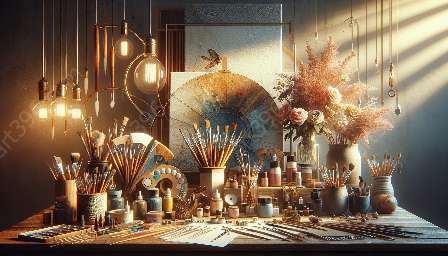When it comes to art, the use of experimental paint and brush techniques can lead to unique and diverse outcomes. However, these methods also have their benefits and drawbacks that artists need to consider. In this comprehensive guide, we will explore the various aspects of experimental paint and brush techniques, how they interact with different types of paints and brushes, and how artists can make the most of their art and craft supplies.
Types of Paints and Brushes
Before delving into the benefits and drawbacks of experimental techniques, it's important to understand the different types of paints and brushes available to artists. Oil paints, acrylics, watercolors, and gouache each have their own unique properties that impact the application and outcome of experimental techniques. Various brush types, such as flat, round, filbert, and fan brushes, also play a crucial role in the execution of these techniques. By understanding the characteristics of each paint and brush type, artists can make informed decisions about the experimental methods they choose to employ.
The Benefits of Experimental Paint and Brush Techniques
1. Creativity and Innovation: Experimental techniques allow artists to break free from traditional norms and explore new avenues of expression. By embracing unconventional methods, artists can push the boundaries of their creativity and produce truly unique artworks.
2. Texture and Depth: Certain experimental techniques, such as impasto and dry brushing, can introduce captivating textures and depths to artworks. These techniques create tactile surfaces and enhance the visual interest of a piece.
3. Expressive and Emotional Impact: Experimental techniques often lend themselves to conveying raw emotions and evoking powerful responses from viewers. By leveraging the unpredictability of these methods, artists can infuse their work with a sense of spontaneity and emotional depth.
The Drawbacks of Experimental Paint and Brush Techniques
1. Unpredictability and Control: Experimentation can lead to unpredictable outcomes, making it challenging for artists to maintain complete control over their artworks. This lack of predictability may be frustrating for artists who seek precise results.
2. Learning Curve: Some experimental techniques require time and practice to master. Artists may encounter initial frustration as they grapple with the learning curve of these methods, leading to potential discouragement.
3. Preservation and Longevity: Certain experimental techniques, such as using unconventional materials or mixing incompatible paints, may compromise the longevity and archival quality of the artwork. Artists must weigh the trade-off between experimentation and the preservation of their creations.
Integration with Art & Craft Supplies
Experimental paint and brush techniques intersect with a wide array of art and craft supplies. From canvases and paper to palette knives and blending tools, these techniques often necessitate specific materials to achieve their desired effects. Understanding how experimental techniques interact with various supplies can aid artists in making informed decisions and maximizing the potential of their creations.
In conclusion, the benefits and drawbacks of experimental paint and brush techniques are multifaceted. By carefully navigating through the nuances of these methods, artists can harness their potential to create captivating and thought-provoking artworks. Embracing experimentation while considering the compatibility with different types of paints and brushes and art & craft supplies can lead to a world of artistic possibilities.

